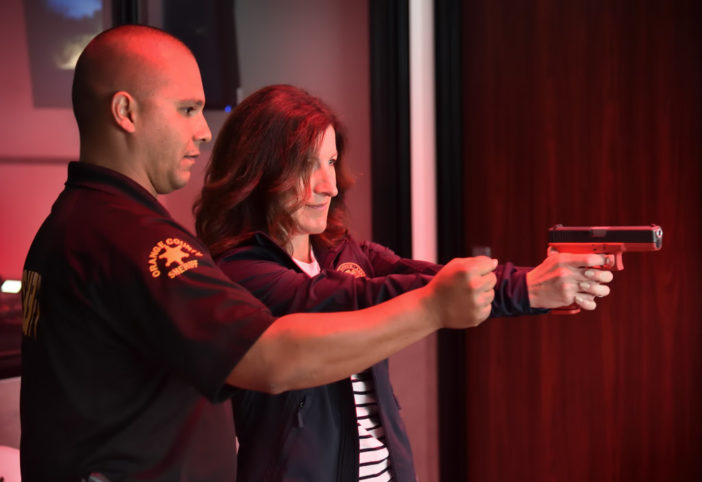For the state Assemblywoman, it was brand-new territory.
“I’ve never touched a gun in my life,” said Cottie Petrie-Norris (D-Laguna Beach) as she walked into the Force Options Simulator Room in the Orange County Sheriff’s Department’s Tactical Training Center (TTC) in Orange.
“Well,” Petrie-Norris added with a laugh, “except a Nerf gun.”
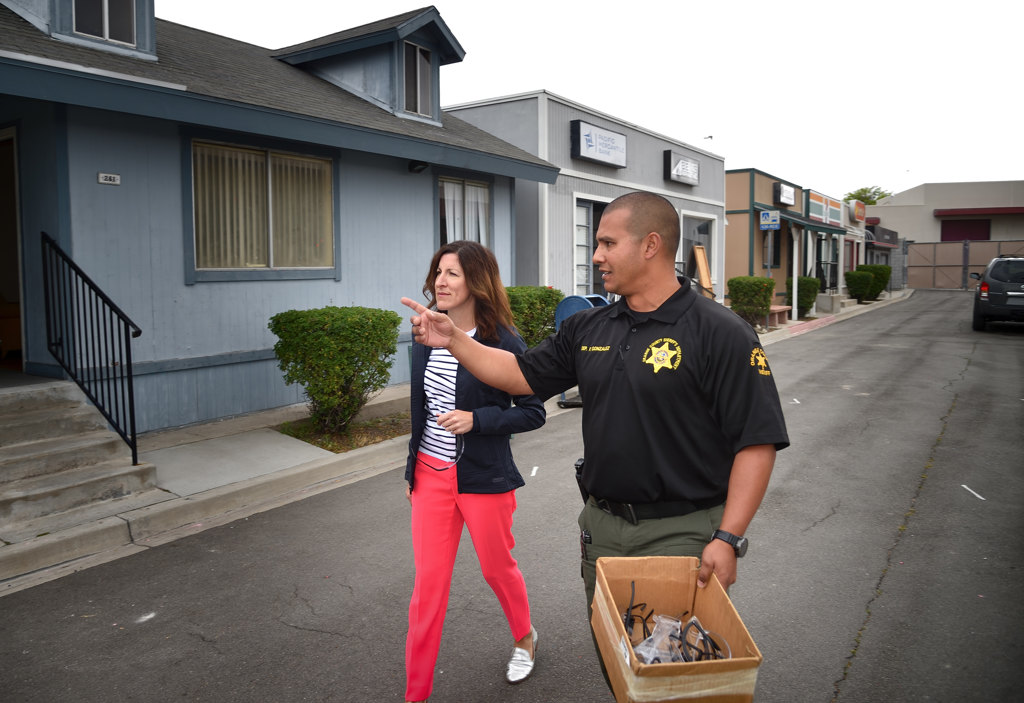
OCSD Dep. Frank Gonzalez takes Calif. Assemblywoman Cottie Petrie-Norris on a tour of a mock town built for training exercises at the OCSD’s Tactical Training Center in Orange.
Photo by Steven Georges/Behind the Badge
Over the following 90 minutes, the lawmaker, whose 74th Assembly District encompasses Huntington Beach, Costa Mesa, Newport Beach, Irvine, Laguna Woods, and Laguna Beach, would be put in the boots of a deputy forced to make split-second decisions on whether to use force in scenarios involving virtual reality and real actors.
Petrie-Norris’ May 10 visit to the OCSD’s TTC, where deputies and officers from 55 agencies throughout Southern California train to learn and hone their shooting and other tactical skills, was a real eye-opener.
“I think that all of my colleagues should do this,” Petrie-Norris said.

Calif. Assemblywoman Cottie Petrie-Norris smiles as OCSD Dep. Frank Gonzalez evaluates her performance at the training simulator.
Photo by Steven Georges/Behind the Badge
Her visit to the TTC launched a series of invitation-only force-option training sessions for O.C. politicians, faith leaders, and other community figures as state lawmakers seek common ground on two competing use-of-force bills making their way through Sacramento.
Assembly Bill 392, which has been approved by the Committee on Public Safety, would update the current “reasonable” deadly force standard to “necessary.” Supporters say the new law is needed to encourage officers to rely on de-escalation techniques instead of lethal force.
Law enforcement leaders, who back a competing Senate bill, say AB392 would create an impossible standard for officers and deputies to meet when faced with immediate danger.
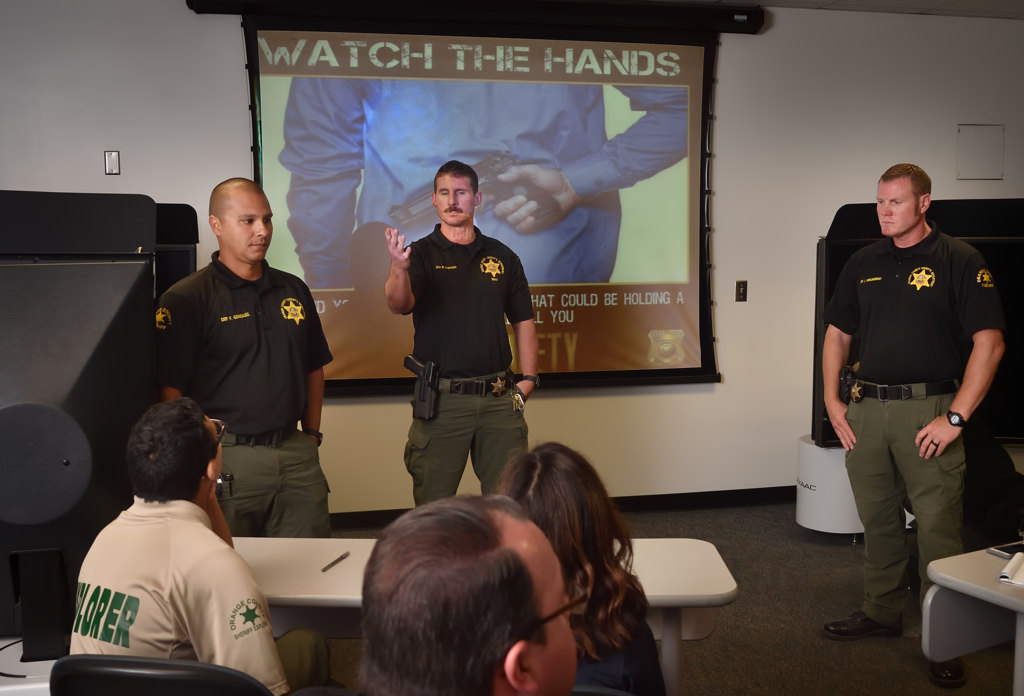
OCSD Deputies Frank Gonzalez, left, Nicholas Stiefken, and Joe Pawlikowski give a talk at the OCSD training facility in Orange on the dangers peace officers face while in the field.
Photo by Steven Georges/Behind the Badge
Petrie-Norris got a vivid sense of such dangers as she went through three virtual-reality scenarios and two other scenarios with actors in a mock town designed for training tactics.
“We rarely get an opportunity to walk in somebody else’s shoes,” she said, “and this is a perfect example of that.”
Sheriff Don Barnes welcomed Petrie-Norris to the TTC, located on Katella Avenue near the 57 Freeway. Lt. Kevin La Pyrne then hosted the force option training with several deputies who work full time at the facility.
“Deciding to use force is not something any peace officer takes lightly, and these situations truly are few and far between,” Sheriff Don Barnes told Behind the Badge. “Out of the more than 363,000 calls for service last year, our deputies used force in .1 percent of those calls. This is a testament to the training of our deputies and their ability to use de-escalation tactics in a variety of situations.”
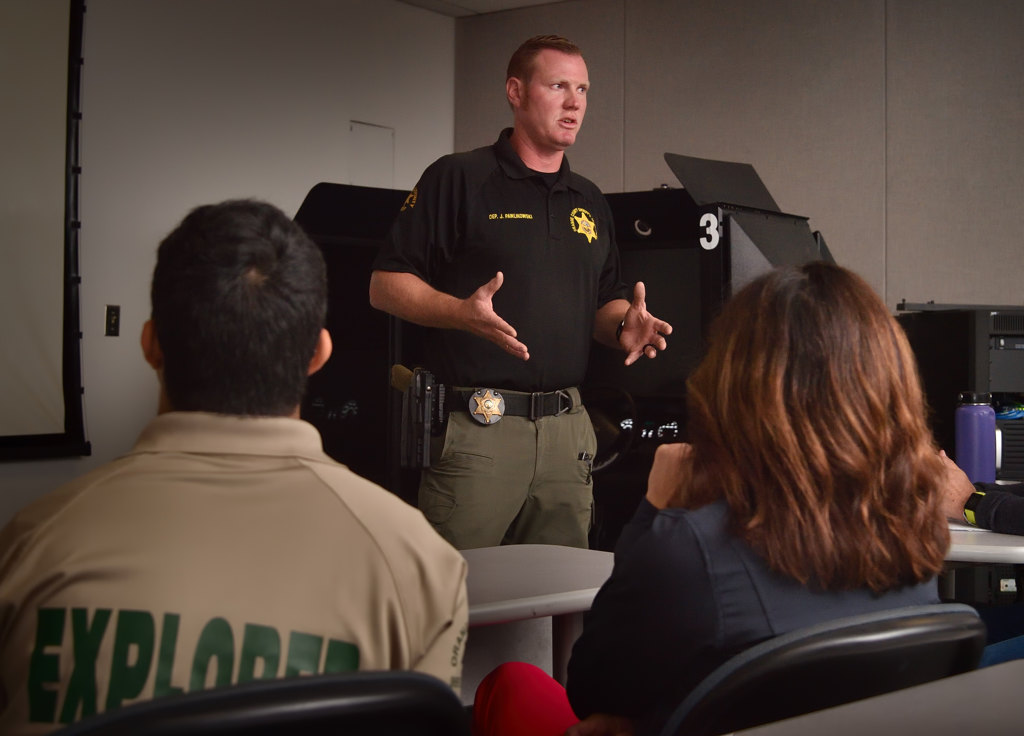
OCSD Dep. Joe Pawlikowski talks about tactics at the OCSD’s training facility in Orange.
Photo by Steven Georges/Behind the Badge
Deputy Isaac Flores, a supervisor at the TTC, welcomed Petrie-Norris in a room equipped with two driver simulation pods. On a screen was this message:
WATCH THE HANDS
The hand you can’t see is the hand that could be holding a weapon that will kill you.
Petrie-Norris then watched a video of a real officer-involved shooting (OIS) in Illinois.
In the 5 a.m. incident, a female patrol officer spotted a man sleeping in an SUV on a gravel road.
Routine car stop?
Or so it seemed.

California Assemblywoman Cottie Petrie-Norris (D-Laguna Beach) with Orange County Sheriff Don Barnes.
Photo by Steven Georges/Behind the Badge
What the officer didn’t know was the motorist was on the run after killing a man in Pennsylvania.
As she looked at his driver’s license and registration in one hand while holding a flashlight in the other hand, he pulled a gun on her.
Acting instinctively, the officer emptied her hands and grabbed onto his gun, begging him not to shoot her. The officer had no time to grab her own gun or the other tools on her belt she had been trained to use.
The struggle ended when a responding partner arrived, realized what was happening, and fatally shot the man through the windshield.
There were three views of the shooting: from the female officer’s body-worn camera, from her partner’s, and from the dash cam in the female officer’s patrol car.
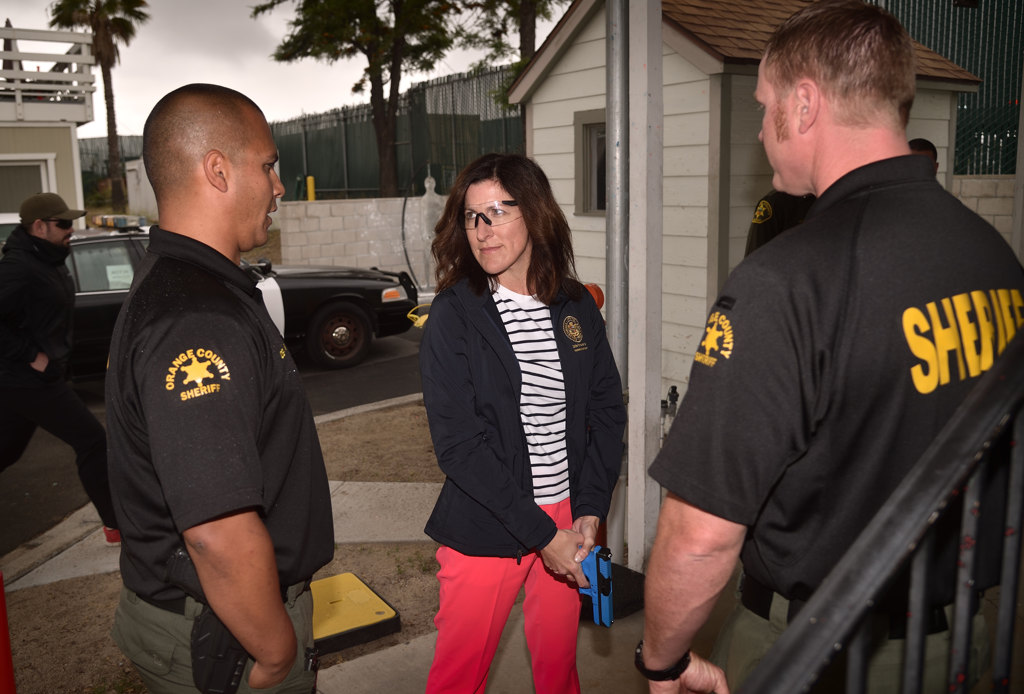
California Assemblywoman Cottie Petrie-Norris stands ready as Dep. Frank Gonzalez, left, and Dep. Joe Pawlikowski give her last-minute instructions before a scenario with actors.
Photo by Steven Georges/Behind the Badge
Depending on which view one saw, one’s interpretation of what happened – and whether lethal force was justified – changed.
“I think this shows you how quickly things can happen,” Deputy Joe Pawlikowski told Petrie-Norris.
The video also illustrated how the court of public opinion can be swayed based on what portions of a video is seen.
Petrie-Norris then went through three virtual-reality scenarios in the adjoining Force Options Simulator Room.
In one scenario, a heavy-set, shirtless man is banging on cars at an airport. He apparently is on drugs or mentally disturbed. He “sees” the officers and rushes them.

California Assemblywoman Cottie Petrie-Norris makes a last-second decision to shoot as three people, two of them armed, come at her yelling different things during scenario training at the OCSD’s TTC in Orange.
Photo by Steven Georges/Behind the Badge
Petrie-Norris fires pepper spray at the unarmed man.
The OCSD deputies tell her pepper spray likely would not have been enough to stop him and her safety had been in jeopardy. Shooting them, they say, would have been justified.
“See how you only had a second to respond?” Pawlikowski asks.
In the second scenario, a suicidal man with a knife is talking to himself in a parking lot when he “sees” the officers approaching.
“You guys want to bother me?” he says. “Why don’t you guys give me some privacy so I can do what I need to do?”
Suddenly, the man drops his knife and rushes toward the officers – in this case, Petrie-Norris, in the Force Options Simulator Room.
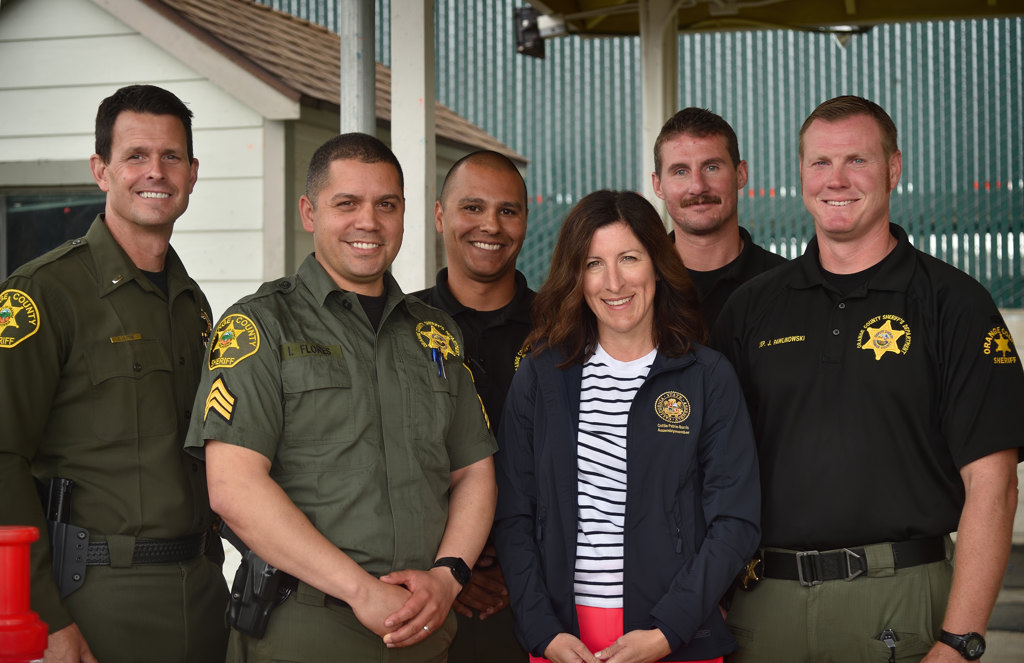
California Assemblywoman Cottie Petrie-Norris, 74th district, with OCSD deputies at their training facility in Orange. From left are Lt. Kevin La Pyrne, Sgt. Isaac Flores, Dep. Frank Gonzalez, Dep. Nicholas Stiefken, and Dep. Joe Pawlikowski.
Photo by Steven Georges/Behind the Badge
She fires off several rounds.
“So,” Flores observes. “You shot an unarmed man.”
“In the knee!” Petrie-Norris responds.
The deputies explain to her how they’re trained to stop the threat and aim for the torso region.
In the third virtual-reality scenario, officers approach a Dodge Ram with tinted windows. The combative driver, unarmed, steps out and approaches them. Suddenly, a passenger comes out and fires at them.
Petrie-Norris blasts off nine rounds.
“That escalated quickly,” one deputy observes.
“The no-look (shot) was a good touch,” another jokes.
One deputy tells Petrie-Norris that ordering the driver to get back into the car may not have been wise because she has no idea what’s in the car.
“How do we handle this and go home at the end of the night?” one deputy asks her.
Silence.
“Tricky, isn’t it?” he says.
Deputies, Petrie-Norris is told, have to approach every encounter knowing that they may have to switch to deadly force in an instant.
“It was scary, even though it’s just a video,” Petrie-Norris says of the three scenarios.
She then went outside to shoot non-lethal training rounds when faced with two scenarios. In one, three people approached her: one with a cell phone shooting video, one holding a knife, and the other holding a gun she eventually fires at Petrie-Norris.
In the second scenario, Petrie-Norris encounters two combative homeless people in an alley. One is holding a knife. When she approaches Petrie-Norris, she shoots her.
“In some ways, it was what I expected,” Petrie-Norris said of the training. “I think the biggest thing was just how real it felt — how scary it felt in the moment. I think it reinforced for me that even deputies that are trained in this line of work – well they’re people, just like everyone else, but their job is very scary.”
 Behind the Badge
Behind the Badge
